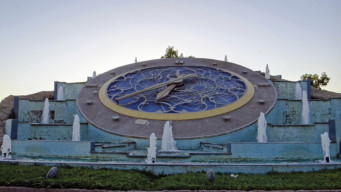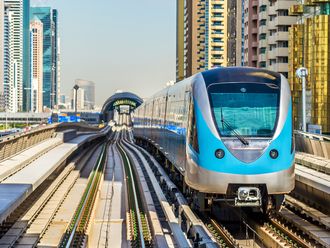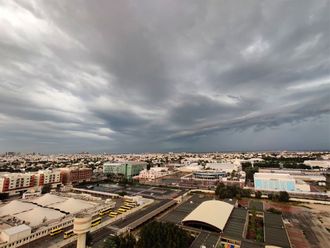
Al Ain: It may be a technological marvel, but you probably never even noticed it. The largest inclined clock in the world ticks away silently in one corner of a busy junction in Al Ain.
The massive unit embodies a glorious Muslim scientific heritage. Conceived and planned almost a decade ago, the imposing structure has somehow never received due importance in a city that strives to showcase itself as a world-class tourist destination.
The clock was planned and built with the cooperation of several departments, including Al Ain Municipality, the Town Planning Department, the Faculty of Engineering of UAE University, the former Al Ain Economic Development and Tourism Promotion Authority, and Smith of Derby — the UK’s world-famous clock manufacturer.
Al Ain Municipality, however, did not respond when approached by Gulf News with queries about the clock, its purpose and plans for the landmark. Nonetheless, residents and visitors merrily take pictures in front of the clock although they know little about it’s claim to fame. Many visitors are baffled as to why it is so poorly maintained. A number of lights on the clock’s dial are not working. Even the LED lights on the hour arm are not working leaving only the minute arm visible at night. A layer of dust covers the dial.
“Wow! I didn’t know it’s the world’s largest inclined clock,” said Alyssa Agapito, a Filipina resident of Al Ain. “Isn’t it a pity that nobody notices its importance,” she said.
She said the clock has great potential to become a tourist attraction.
Mohammad Farooq, an Indian expatriate, said the clock had aroused his curiosity but he could not understand its purpose. “It must have had a purpose and a plan that’s now been dumped silently,” he said calling for the authorities to pay some attention to the marvellous piece of work.
The clock’s design is an inspiration from the ancient astrolabe, an instrument used by astronomers, navigators, and astrologers for measuring angles of an object. The astrolabe technology is believed to have originated in the Middle East with Muslim scientists playing a lead role in its development.
The clock has a diameter of 13 metres and its design is based on the theme of stars and planets. According to Smith of Derby, the theme is expressed through thousands of twinkling fibre optics set within the concave midnight blue dial background. A battery of bright LED lamps is concealed within the rim of the dial to cast a halo effect around the edge.
The drive unit of the clock alone weighs a metric tonne and has been manoeuvred into its housing at the clock’s base. The clock has been positioned at an angle of 28 degrees from vertical in accordance with the incline of the dial. The surface of the dial has been finished with blue and gold leaf tiles with a pattern of swirling stainless steel astrolabe scrolls.
“It is arguably the biggest inclined clock in the world,” said Smith of Derby, who have provided many clocks in the Middle East including installations in Makkah. The unit has giant hands that measure eight metres from tip to tip for the minute indicator and six metres for the hour hand. The hands are fitted with roller bearings at the outer ends to ensure smooth operation. A red laser has also been mounted under the minute hand that projects a straight beam of light on to the adjacent hour mark.
Timed bubbler fountains have been installed in the circle, designed like a planetary ring, around the dial from which water flows into shallow blue-tiled pools, the manufacturers said.
The interchange, where the clock sits, was previously known as the Clock Tower Roundabout but has now been named Time Square. The Roads and Bridges Section of Al Ain Municipality and Town Planning Department demolished the Clock Tower roundabout in the early 2000s as part of development projects in Al Ain.
The clock tower itself was one of several similar landmarks built in Abu Dhabi, Dubai and Al Ain in the 1970s. An intersection with signals later came up at the site, which lies on Shaikh Zayed Bin Sultan Street (popularly known as Main Street).












